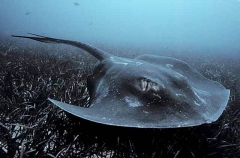Smooth Stingray (Dasyatis brevicaudata)
All text on this page is copyright protected: © 2014 Kelvin Aitken.
All rights reserved. Students may use this information for personal research only. Not for commercial use.
Order: Myliobatiformes
Family: Dasyatidae
Genus: Dasyatis
Species: brevicaudata
Taxonomic name: Dasyatis brevicaudata
Other Common Names: Giant Black Ray, Giant Stingray, New Zealand Short-tail Stingaree, Short-tailed Black Ray, Smooth Short-tailed Stingray, Short-tail Stingray.
The largest of the world’s stingrays is the Smooth Stingray (Dasyatis brevicaudata). It can weigh well over 350 kg, measure over 2 m across the wings and have an overall length of 4.5 m. They are 36 cm across the disc at birth. It is common throughout its range, from southern Queensland around the south coast to Shark Bay in Western Australia.
The Smooth Stingray is dark grey to black above with a distinctive pattern of small white spots scattered across the base of the fins below and behind the eye. The tail is thick with a single row of blunt thorns ending with one or two barbed spines midway along the tail which then quickly tapers to a point. Anglers and commercial trawlers often catch this large ray and cut off the tail to prevent injury to themselves before throwing the ray back resulting in many of these rays getting by with amputated tails.
During summer months the Smooth Stingray can be found in water as shallow as 1 m or less, especially where fish are being cleaned, for example near boat ramps or piers. It has also been taken by trawlers and drop line fisheries in water as deep as 500 m. The Smooth Stingray is curious and will approach swimmers and divers, especially if there is bait or berley in the water. While these animals are easily trained to take hand-held bait, they are potentially dangerous if they retain their large barbed spines. When threatened, cornered or molested they will curl their tail up and over their back in a threat display.
The tips of the long thin tails of stingrays, whiprays, eagle rays and devilrays are fragile and often damaged. Therefore with these animals body size is measured across the wingtips.
